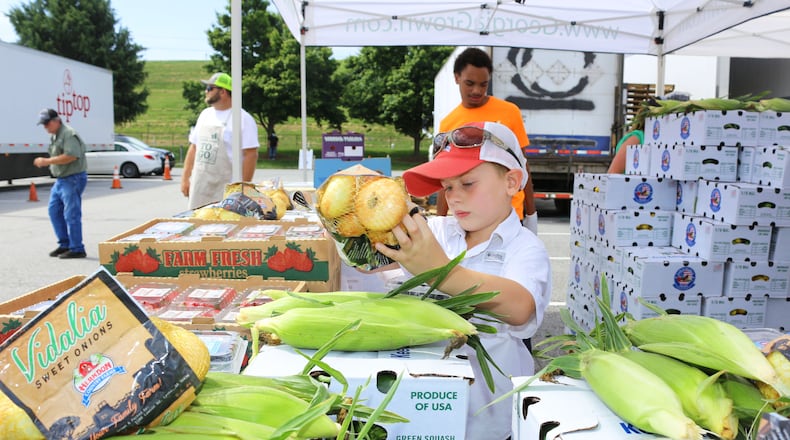Jimmy Webb and his brother, Wesley, planted 1,000 acres of corn this year, 1,000 acres of peanuts and 1,000 of acres of cotton, but their South Georgia fields haven’t yielded what they hoped.
Some of the blame for that can be laid on the many tropical storms blowing through this year.
Add to the wet weather these other challenges faced by the Webbs and many growers in the state: retaliatory Chinese tariffs that cratered key Georgia farm exports, cheap imports from Mexico, disruptions due to the coronavirus pandemic, clouds of white flies infesting cotton fields and herds of wild hogs ravaging corn fields.
Right now, Georgia’s agricultural heartland is just four plagues short of the 10 that brought Egypt to its knees in the biblical book of Exodus.
Without financial bailouts from the federal government, many Georgia farmers would have been in deep trouble this year. About 36% of U.S. farm income in 2020 will be from federal payments, according to an estimate by the University of Missouri. That includes money for the losses caused by President Donald Trump’s Chinese trade war, weather disasters and the pandemic, on top of the usual subsidies.
Georgia farmers will collect $341 million from tariff relief payments alone, the University of Georgia estimates. A recent U.S. Government Accountability Office report noted that Georgia farmers got the highest bailout payments in the U.S. per individual in the nation — an average of $42,545.
“Without the government, we would be in a lot of trouble,” Webb said.
Many Georgia farmers threw their support behind Trump, as did the overwhelming majority of the state’s rural areas.
Credit: HYOSUB SHIN / AJC
Credit: HYOSUB SHIN / AJC
“You are in a red kingdom down here,” said Jon Schwalls, the executive officer of Southern Valley Fruit and Vegetable, which farms about 3,000 acres near the Florida state line.
Nobody switched gears, he said, despite the disruptions brought on by Trump’s trade policies.
China had become a major market for Georgia pecans, cotton and other produce. But that market dried up when the U.S. placed hundreds of millions of dollars in tariffs on Chinese imports in an attempt to force China to the negotiating table to resolve trade issues, such as theft of intellectual property. China retaliated with heavy tariffs on U.S products.
But, Webb said, “the government has helped us weather that storm.”
He added that the government is fighting to make sure world markets treat Georgia farmers fairly.
Samantha McLeod of the Georgia Pecan Growers said the consensus among members is that the tariffs will make things better in the long run.
″It is kind of upsetting that pecans have become sacrificial lamb with the trade war, but they are still in support of it to make sure U.S. producers are looked after," she said.
The rough patch for farmers has stretched back beyond the trade war to about 2014. In 2013, the cash receipts for Georgia farm products reached more than $10 billion, according to the U.S. Department of Agriculture. By 2016, that had slid to $8.5 billion as different segments were hit with problems, from droughts to frost.
Georgia weathered 2018′s Hurricane Irma and the same year Hurricane Michael, which damaged 17% of the state’s pecan trees and caused more than $2.5 billion in agricultural losses. Late torrential rains that year also ruined some cotton and peanut crops.
Farmers were slowed in early 2019 by a government shutdown, which delayed loans and crop planning.
Tariffs have cut sales for the last two year, with income dropping in 2019 to $8.4 billion even though the infusion of government relief had begun. At the same time, bankruptcies started creeping up in Georgia last fall.
Webb said he hasn’t heard about any of his colleagues walking away. “But, if we didn’t have that help from the government, we would have seen a lot more of that," he said.
His flat Calhoun County fields are a few hours south of the lineup of glass offices in Alpharetta and Atlanta that bear the names of some of the nation’s best known tech companies. Though those types of businesses grab attention, farming is still Georgia’s largest single industry. It sustains 399,000 jobs and adds $76 billion to state output, according to a 2020 University of Georgia calculation.
In the spring, it looked like Georgia’s vegetable industry was in line to be pummeled when the coronavirus hit and drastically dropped sales to restaurants and institutional buyers, which soak up about half the crops. Florida farmers were already plowing under fields of peppers and tomatoes.
Then consumers began buying more vegetables at markets, and the government started a $4 billion federal purchasing program.
“2020 has been a good year but a crazy year” for vegetable farmers, Schwalls said.
“The year as a whole, it’s like a football game. You have some bad quarters and some good quarters. But, at the end of the day, it looks like a win.”
Georgia’s signature peach crop, which receives little in government support, did OK after some bad weather years. Summer corn came in good and was a money-maker for Webb and others.
But the state’s bread and peanut butter crops — cotton ($793 million), peanuts ($625 million) and pecans ($218 million)— are still in harvest, and the constant tropical storms this summer and fall have hindered final growth and getting crops in.
Credit: HYOSUB SHIN / AJC
Credit: HYOSUB SHIN / AJC
“Peanuts are about 1,000 pounds (an acre) less than anybody was thinking they would be,” said Reece Foster, who farms about 1,000 acres near Albany.
Late September rains threatened to cause some crop rot. Earlier rains kept cotton bolls from blooming fully, which reduced yields. Cotton prices per pound, depressed by the effect of tariffs, have begun to climb back to the 70 cent mark in recent days.
“It’s not great money, but you are getting closer to money-making if you have a good yield,” Foster said. “You can break even, but you won’t be buying a beach house this year.”
Not all farmers qualified for federal help, and bailout money went to the largest farms. An analysis of national and state payouts showed that 77% of the bailout money went to 20% of the largest farms. The bottom 80% of farmers got only 23% of the money, and the average payment was a little over $9,000.
“I have not seen as much in payments this year from the government," Foster said. "But you can’t base farming off government payments. That won’t work.”
Despite the lingering problems, Webb said he and other farmers are already looking forward to next year.
“Every January 1, farmers are the most optimistic people in the world,” he said.
Georgia’s top agricultural products
No. 1 in the nation in:
Broiler chickens
Hatching eggs
Peanuts
No. 2 in the nation in:
Cotton
Pecans
Rye
No. 3 in the nation in:
Peaches
Sweet corn
No. 4 in the nation in:
Bell peppers
Pullets
Watermelon
No. 5 in the nation in:
Blueberries
Cucumbers
Table eggs
Tobacco
About the Author
Keep Reading
The Latest
Featured




